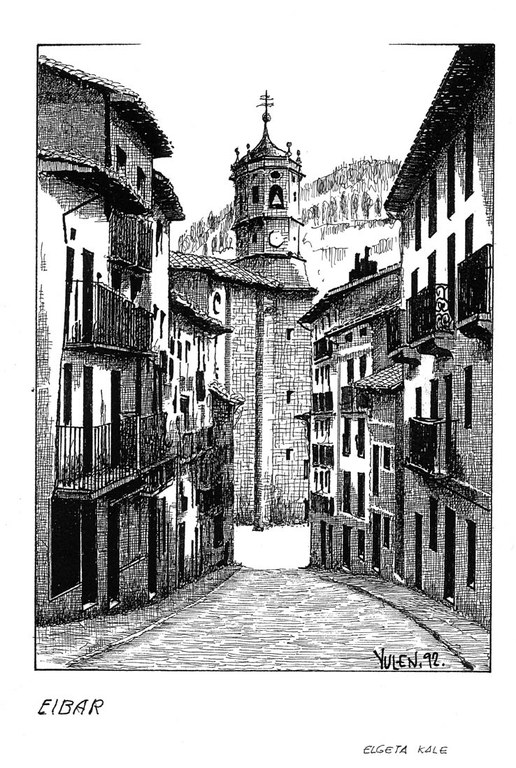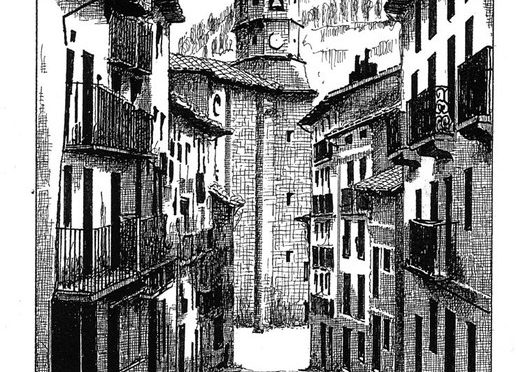Eneko Ennekõike, who is passionate about his home town of Eibar, told me about Julen Zabaleta, a long-time resident of Eibar who died at the age of 101 a few months past. Julen lived through the Spanish Civil War and World War II. He saw the world change dramatically over the last 100 years, with the advent of computers, television, and the internet. Through it all, he documented the people and places of Euskal Herria with his pens and pencils, memorializing the buildings and traditions that are a key part of the Basque Country’s charm, identity, and history.

- Julen, or Yulen as he was known artistically, was born in Elgoibar on February 14, 1921. However, he lived most of his life in the nearby town of Eibar, moving there in 1951 when he got married to Hortensia San Martín (he once said that while God determines where a man is born, his wife determines where he lives). He was the oldest of five children born to Telesforo Zabaleta and Josefa Barrenetxea. Telesforo worked as a mail carrier, driving a six-horse cart to deliver mail between towns. He would also take various goods and, sometimes, bathers who wanted to visit the baths in Altzola.
- Yulen began his professional life in the forges of Elgoibar, but after his military service, he worked as a designer and draftsman for many of the local companies. He would draw the parts of machinery, in perspective, so that others could put the machines together. Even after retirement, he kept working. He couldn’t stop. He would say that the body is lazy, and it needs movement.
- His love of drawing began at an early age. When he was six years old, his father gave him a pencil and he was drawing ever since. When he was nine, he was at a cousin’s house, who had an encyclopedia, which he opened to a photograph of a horse and began drawing. He was mostly self-taught, practicing into the late hours in his bedroom. Over his lifetime, he drew some 8,000 pictures, mostly historical buildings of the Basque Country and the occupations and traditions of the past. A PDF of one of his books filled with drawings of Goierri can be found here.
- His passion for buildings began with towers in Gipuzkoa, and then to hermitages. He learned the history of the buildings he drew. A lot of hermitages, for example, were built by Basques who had gone to America and made their riches, returning with gold teeth and building the hermitages to share their fortune with their countrymen.
- To celebrate his 100th birthday, and the 675th anniversary of Elgoibar, released a book entitled Yulen 100 urte in early 2022, to go with an exhibition of the same name from the previous year. Yulen died on February 26, 2022, at the age of 101.
Special thanks to Eneko Ennekõike for teaching me about Yulen.
Primary sources: 100 urte, milaka irudi, Barren 1190, 02/12/2021; Julen Zabaleta, marrazkilaria: “Igarri barik etorri zaizkit 100 urteak, entretenituta egon naiz orain arte,” eta kitto!; Julen Zabaleta ‘Yulen’ hil da, eta kitto!
Discover more from Buber's Basque Page
Subscribe to get the latest posts sent to your email.



Very nice artwork. Reminds me of my father’s hometown of Arizkun, Valle Bastan, Navarre, which is just north of Elizondo. My father was born to a peasant family which work leased land and his house was called Miaca. My father was Juan Eliodoro Arrachea.
Maybe we are cousins.
Wonderful story. My husband and I visited Eibar around 2012. We stayed up from the town in a B and B called Sosolla. ( not sure of spelling). It was a magical old farm house built around 1465. I felt very much “at home” there… even more so there than my grandparents’ villages of Lekeitio and Sumbilla. I hope someday to go back to Eibar and stay in that magical home. Thank you for your stories of the motherland! Celeste Zamora Povey. Reno, NV